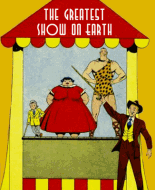|
Smitty #2 1948 - Smitty In The North Woods
After reading this book again for this exercise, I realise that it probably isn't the best choice of the Smitty books to entertain The Reading Club's readers (although the average humour in the comedy newspaper comic strips of The 1920s, and '30s would seem very dull and stilted to modern readers, in any case. Unfortunately, even the "cleverest and funniest " of the Smitty stories wouldn't be better enough to change the general impression. I probably should have chosen "Bringing up Father", instead, represented here at CB+, in one of the early Dell or Ned Pines' Standard Comics "Jiggs and Maggie" issues. Berndt's artwork is decent, but not good enough to carry the old-fashioned humour. And, the Western Tradition's success story, of "the clever young boy outwitting the experienced old man" theme is too old and too often used to interest new readers.
(1)Smitty (Herbie(Herby)) 1-Page Gag
Smitty's little brother shows some cleverness in playing a harmless but annoying trick on a mean soda jerk. I guess it's likely to be dull to most readers. And probably only a little nostalgic for readers who had previously seen the prank played on someone.
(2)Smitty - "In The North Woods" (Title given for Cupples and Leon's 1932 book reprinting of the newspaper strip)
Unfortunately, Western Publishing's project editor dropped the ball from the start of this book, by not adding a narrative box, with an introduction summary of what occurred in the newspaper strip portion of this "story" before this book's first page. He chose to eschew that "favour" to the readers, as Smitty's and his Boss, George Bailey's guide reading the letter that tells him they'll be arriving is a decent place to start the story for a novel, as all the information they need to know to follow the story COULD possibly follow, to establish the main characters' relationship, and why they are taking the trip. However, as any good comic book editor will tell you, "each comic book needs to stand on its own", as if its purchaser/reader has never before read its series, or seen its characters. So, by necessity, a basic impression of the character of the series main actors and their motivations and at least a hint of the immediate setting must be shown very early in the story (most often on its first page, especially in stories with a short page count). And so, for stories of less than 20 pages, it's usually a hard and fast rule that the story's main character MUST appear on its first page (which is why the half-page splash panel containing Smitty and his Boss was made especially for this printing. However, because that scene used in the first panel occurred much later in the story. So, by already breaking a cardinal rule of not showing the main characters in "real time" on its first page, the narrative box with a brief synopsis of what's happened before, is needed.
I see now that Smitty and his boss' guide, George, does on Page 2, reveal that he will be their guide on their hunting trip. This would be very repetitive IF a preliminary narrative were used. So, not having the main characters on the first page in real time causes an awkward conundrum that can't be fixed. Worse yet, Smitty and his Boss appear, out of nowhere, with no narrative. Their dialogue explains some of what the reader needs to know. But, at ther VERY LEAST, the editor should have added a narrative box with the word, "Meanwhile....", or "Meanwhile, not far away.... ". As I and several others commented above, the amount of repetition is ridiculous, and so, very annoying. The mild "jokes" are very weak, and uncreative.
The story moves slowly, with not a lot happening. The pacing never moves towards a creschendo and a big climax (showdown). It just ends. That implies this is just a "slice of life", as opposed to having an important story to tell that includes some kind of conflict or soul searching. So, I feel that I chose a fairly uninteresting comic book to review. I feel that The "Bill Bumlin" book is a better choice, because, although not terribly funny nor well-structured, it provided fodder for constructive criticism, and lerssons in "what NOT to do, and what to aspire to in comic book story writing.
(3) Smitty(Herbie) 2nd 1-Page Gag
This 2nd Herbie gag again shows him being clever, in tricking his dog into the bathtub, for a bathing that most dogs hate. It's not terribly funny, but brings a smile.
(4) Smitty 1-Page Gag
Lots of buildup of both Smitty and his Boss to have a fun day at the baseball game, cheering for their favourite team. After all that cheerful anticipation, there's a surprise at the end that they aren't sable t do any cheering because they are afraid that the giant bully-type fan of the out-of town team would not like their cheering for the home team, and might get physical about it, IF they would dare to do so. Again, not terribly funny, but brings a faint smile.
|



